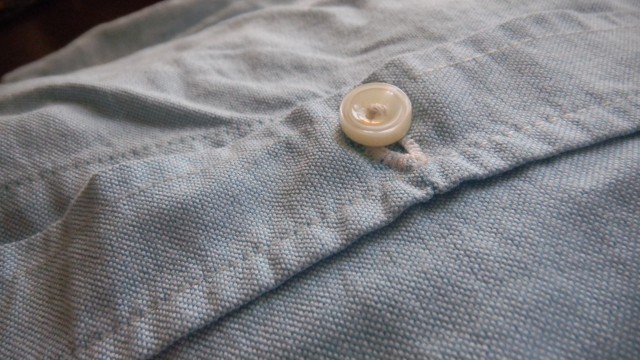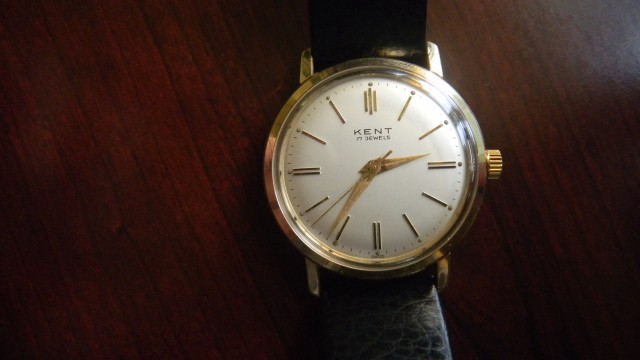The Wise and Honest Can Repair
by Stefan Zajic

You can pay people to fix the things you can’t, but it’s happening less and less. Despite the recession-induced uptick in the shoe repair business, the repair business has been in a general decline for decades: As the WSJ noted, there were 7,000 shoe repair shops in the U.S. in 2009, down from 120,000 during the Great Depression. Getting things repaired used to be a common part of life, but now, aside from cars and bikes, people don’t have things fixed all that often. If you’re not in the habit of doing so, it can be hard to know where to go (repair shops are often very small, one-man or mom and pop businesses), or how much it will cost — oftentimes it feels easier to just buy a new one of whatever it is you need repaired. Lately, I’ve been trying to repair more things instead of buying new ones:
Buttonhole, $6. After a year of wearing my favorite blue button-down shirt at least once a week, the bottom buttonhole began to fray. Buttons are easy enough to sew on, but buttonholes are tricky, so I took it to a tailor for repair. I’d had him alter my suit and a couple of pairs of pants, but I wasn’t sure if it would be worth the cost to repair a buttonhole.
“Six dollars,” he said.
“Perfect!” I exclaimed, feeling great about getting my shirt fixed, instead of buying another. I felt less great when I got back to my car and found that I’d forgotten to put money in the meter, so I’d picked up a $35 parking ticket. I’m still not sure if the buttonhole repair cost $6 or $41, but I think about the repaired hole every time I put on the shirt.


Watch, $145. For some reason that seemed important at the time, I thought that it would be romantic, or cool (or both) to wear an old mechanical watch at my wedding — a nod to simpler times when watches were more complicated and less accurate. Watches these days are essentially jewelry, since everyone carries a phone, but I didn’t want to be continually checking my phone on my wedding day, and I figured I might as well try to look classy. I found a simple, elegant old automatic watch on eBay for about $50, and replaced the worn out band for another $15. It looked great, but lost about five minutes a day.
So I took it to a great little watch repair kiosk at the mall. The guy there, George, always replaces the batteries in my watches for $4. He initials and dates the batteries, and if they run out of juice in less than a year, he’ll replace them for free. But he couldn’t fix the watch, and while it was at the shop, I got married, wearing a perfectly nice watch my parents had given me years before.
Many months later, I decided that I’d get the old watch repaired. It’d be nice to have on hand for formal occasions, I thought, and maybe it would make a meaningful heirloom someday. I eventually took it to a tiny, one-man shop in a small room on the second floor of a building in Philadelphia’s diamond district. It cost $145 (cash only) to fix — much more than the price of the watch. You can even buy a few, though not many, automatic watches new for less than that. But I decided this one was worth repairing because of its age, because otherwise it would be discarded, which felt wrong, and because I’d bought it for my wedding, even if I didn’t wear it that day.

Two driver’s side mirrors, $360. On the morning of my birthday this year, I discovered that someone had smashed my driver’s side rear-view mirror, taken it clean off. I called the police, and an officer came by to take the report. He was sympathetic. He said that last summer, he’d been involved in a shooting, and he’d had to go to therapy to make sure he was dealing with it OK. While he was in one of his therapy appointments, someone smashed one of the windows of his brand new car. Pure vandalism — they didn’t even take anything. He told me that I shouldn’t bother with my insurance company, since it would cost less than the deductible to fix the mirror. He was right. I took it to my mechanic, Carlos, who put on a generic version of the mirror and mounting for about $180, installed. So it goes, I thought. Life in the city.
I was a lot less zen when it happened again a month later. To the very same mirror, the brand new one that had just been put on! This time, instead of vandalism, it was hit by a passing car. “Too bad it wasn’t the passenger side, then they’d match!” Carlos said.

Money is an everyday, universal thing (even though it’s not even a real thing at all), but spending it can feel so completely different depending on the circumstances, even when it’s all for the same purpose: repairs. I was just paying people to fix things that I couldn’t, but I felt proud to spend $6 on my buttonhole, stupid to waste $35 on a parking ticket, sentimental to drop $145 to fix an old watch, bummed but relatively stoic about the first $180 for the mirror, seriously pissed about the second $180.
When you repair something you own, those feelings become part of the object itself, since it wasn’t replaced with a new, un-imbued version. Repairing makes the world of everyday objects a bit richer. Putting on that blue shirt reminds me to feed the meter, and more generally to mind the little things. Getting into my car makes me wonder if I should move out of Philadelphia. Each of these objects connects me to a series of minor memories that otherwise might have drifted away if not anchored in the material world. For me, that’s reason enough to keep taking my broken things to small shops in the hope they can be restored.
Previously: Why You Should Shop at Ethnic Grocery Stores
Stefan Zajic lives in Philadelphia and thinks about science all day. Photos by Stefan.
Support The Billfold
The Billfold continues to exist thanks to support from our readers. Help us continue to do our work by making a monthly pledge on Patreon or a one-time-only contribution through PayPal.
Comments